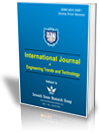WBS-Based Construction Safety Risk Management in High-Rise Building Projects Using A Design-Build Contract System
WBS-Based Construction Safety Risk Management in High-Rise Building Projects Using A Design-Build Contract System |
||
 |
 |
|
| © 2025 by IJETT Journal | ||
| Volume-73 Issue-3 |
||
| Year of Publication : 2025 | ||
| Author : Mega Shine Payungallo, Rosmariani Arifuddin, Rusdi Usman Latief, Henrianto Masiku |
||
| DOI : 10.14445/22315381/IJETT-V73I3P118 | ||
How to Cite?
Mega Shine Payungallo, Rosmariani Arifuddin, Rusdi Usman Latief, Henrianto Masiku, "WBS-Based Construction Safety Risk Management in High-Rise Building Projects Using A Design-Build Contract System," International Journal of Engineering Trends and Technology, vol. 73, no. 3, pp. 237-280, 2025. Crossref, https://doi.org/10.14445/22315381/IJETT-V73I3P118
Abstract
The development of high-rise building infrastructure is often associated with a country's economic progress and modernization. A design-build contract system is one of the options for implementing the construction of high-rise buildings, as it provides a unified responsibility for both design and construction. There are many construction safety risks in its implementation, both in the design and construction phases. A handling model is needed to enable design-build service providers to mitigate and minimize losses during project implementation. This research formulates a model by identifying the causes of risks through work definition using the work breakdown structure, which is then processed using quantitative descriptive and fuzzy logic methods. The research results indicate that the most risky work in the design phase is the Development of Design (DED), and the most risky work in the construction phase is foundation work, basement work, and upper structure work. It is also found that all construction safety risks at the design phase are categorized as medium risk, and at the construction phase, there are 34 high risks, 136 medium risks, and 112 low risks. Furthermore, it is found that the dominant control in both the design and construction phases is administrative control.
Keywords
Construction, Safety risk management, WBS, High-rise building, Design-build.
References
[1] Mohamad Abdul Nabi, and Islam H. El-Adaway, “A Rating Score for Assessing the Risks and Challenges Associated with Modular Construction,” Proceedings Construction Research Congress, Arlington, Virginia, vol. 3, pp. 483-492, 2022.
[CrossRef] [Google Scholar] [Publisher Link]
[2] Nurul Samania, Nirsal, and Riska Yanu Fa’rifah, “Design and Development of the E-Voting Application for the Election of the General Chairman of the Informatics Student Association (Hmti) of Cokroaminoto Palopo University Based on the Website,” D'computare: Scientific Journal of Information Technology and Computer Science, vol. 10, no. 1, pp. 49-53, 2020.
[CrossRef] [Google Scholar] [Publisher Link]
[3] Bambang Sudibyo, and Manlian Ronald A. Simanjuntak, “Analysis of Risk Factors and Variables of Design and Build Contracts,” Civil Engineering, Environmental, Disaster & Risk Management Symposium (CEEDRiMS) Proceeding, pp. 249-254, 2021.
[Publisher Link]
[4] Amendment to the Regulation of the Minister of Public Works and Public Housing Number 1 of 2020 concerning Standards and Guidelines for Procurement of Integrated Design-Build Construction Works Through Providers, Regulation of the Minister of Public Works and Public Housing Number 25 of 2020. [Online]. Available: https://peraturan.bpk.go.id/Details/159657/permen-pupr-no-25-tahun-2020
[5] Florence Yean Yng Ling et al., “Predicting Performance of Design-Build and Design-Bid-Build Projects,” Journal of Construction Engineering and Management, vol. 130, no. 1, pp. 75-83, 2004.
[CrossRef] [Google Scholar] [Publisher Link]
[6] Gabby Andina Ganesdhi, Yusuf Latief, and Danang Budi Nugroho, “Development of Risk Based Work Breakdown Structure (WBS) Standards for Integrated Design and Construction Phase on Design-Build Method of Architectural Works of High-Rise Building to Improve Construction Safety Performance,” International Journal of Science, Technology & Management, vol. 4, no. 4, pp. 792-801, 2023.
[Google Scholar]
[7] Aminu Darda'u Rafindadi et al., “Data Mining of the Essential Causes of Different Types of Fatal Construction Accidents,” Heliyon, vol. 9, no. 2, pp. 1-15, 2023.
[CrossRef] [Google Scholar] [Publisher Link]
[8] A. Anandraj, and S. Vijayabaskaran, “Construction Safety Audit and Analysis - A Conceptual Approach on Needy Implementation for the Metropolitan City - Chennai, India,” Scholars Bulletin, vol. 6, no. 8, pp. 190-197, 2020.
[CrossRef] [Google Scholar] [Publisher Link]
[9] Timothy R. Driscoll et al., “The Role of Design Issues in Work-Related Fatal Injury in Australia,” Journal of Safety Research, vol. 39, no. 2, pp. 209-214, 2008.
[CrossRef] [Google Scholar] [Publisher Link]
[10] Junying Liu et al., “Impact of Design Risk on the Performance of Design-Build Projects,” Journal of Construction Engineering and Management, vol. 143, no. 6, 2017.
[CrossRef] [Google Scholar] [Publisher Link]
[11] R. Ghousi, M. Khanzadi, and K. Mohammadi Atashgah, “A Flexible Method of Building Construction Safety Risk Assessment and Investigating Financial Aspects of Safety Program,” International Journal of Optimization in Civil Engineering, vol. 8, no. 3, pp. 433-452, 2018.
[Google Scholar] [Publisher Link]
[12] Susy Rostiyanti, Ario Bintang Koesalamwardi, and Christian Winata, “Identification of Design-Build Project Risk Factors: Contractor’s Perspective,” International Conference on Advances in Civil and Environmental Engineering (ICAnCEE 2018), MATEC Web of Conferences, Jakarta, Indonesia, vol. 276, pp. 1-8, 2019.
[CrossRef] [Google Scholar] [Publisher Link]
[13] Bożena Hola et al., “Dangerous Events Related to the Use of Scaffolding,” Technical Journal, vol. 7, pp. 31-39, 2017.
[CrossRef] [Google Scholar] [Publisher Link]
[14] Project Management Institute, A Guide to the Project Management Body of Knowledge, Project Management Institute, 7th ed., pp. 1-368, 2021.
[Google Scholar] [Publisher Link]
[15] Jack T. Marchewka, Information Technology Project Management: Providing Measurable Organizational Value, Wiley, pp. 1-368, 2015.
[Google Scholar] [Publisher Link]
[16] Construction Safety Management System Guidelines, Minister of Public Works and Public Housing Regulation Number 10 of 2021. [Online]. Available: https://peraturan.bpk.go.id/Details/216875/permen-pupr-no-10-tahun-2021 [17] Concerning Buildings, Law (UU) no. 28 of 2002. [Online]. Available: https://peraturan.bpk.go.id/Details/44487/uu-no-28-tahun-2002
[18] Construction Services, Law (UU) no. 2 of 2017. [Online]. Available: https://peraturan.bpk.go.id/Details/37637/uu-no-2-tahun-2017
[19] Pejman Rezakhani, “Fuzzy Risk Analysis Model for Construction Projects,” International Journal of Civil and Structure Engineering, vol. 2, no. 2, pp. 516-531, 2011.
[Google Scholar] [Publisher Link]
[20] Charles Ezemonye Alaneme, and Anthony Clement Igboanugo, “Managing Marginal Oilfield Risks with Fuzzy Logic and Monte Carlo Simulation for Economics Optimization,” Journal of Emerging Trends in Engineering and Applied Sciences, vol. 3, no. 4, pp. 660-667, 2012.
[Google Scholar] [Publisher Link]

